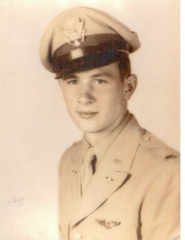Harlan Lill

Harlan Lill
HARLAN
LILL
SOLDIER DETAILS
BIOGRAPHY
Sunday afternoon, Dec 7, 1941, I was listening to a football game on the radio, (I think Texas U. vs. Southern Methodist). Suddenly, a newscast broke in to say Japan had just bombed Pearl Harbor. Little did I, or anyone else at that moment, realize how that brief announcement would change all our lives. After graduation, I enrolled at the University of Kansas (KU) and managed a semester before my draft number came up. As I'd always wanted to fly, volunteering allowed me to choose the Army Air Corps. Boot camp was a radical change. There was a lot of sickness, earning the base the title of 'Pneumonia Gulch.' I was assigned to more training in Eau Claire, WI, then Santa Ana and Oxnard, CA. After 7-10 hours of training in a Stearman, I soloed---a big occasion! The bi-plane was sturdy and great for aerobatics, but its narrow landing gear made it susceptible to ground looping on landing. Primary flight training, 80-90 hours, concentrated on teaching us to recover from unusual/dangerous situations. At Merced, CA we flew the BT-13 Vultee, a single wing, larger and more powerful plane with an enclosed cockpit. It was called the 'Vultee Vibrator' as when in a spin it would vibrate and shake. One of the 'tricks' the instructors used on our first flight was to put the plane in a spin at about 7,000 feet, asking us to count the turns. Still talking (and about the time we reached 13 or 14) they said, 'don't ever allow this plane to spin more than 10 times as it wraps up so tight you can't recover.' That tested your fear and reaction time very quickly! With graduation, I went from Air Cadet to 2nd Lt., becoming co-pilot on a B-17. Our crew came together in Ardmore, OK, to begin flight training as a unit. If any dissent was noted, crew changes were made because it was important to work as a team, as each one's life may depend on the others. Being responsible for the lives of nine others at just 19 makes you grow up fast! Oddly enough, many pilots did not even have a driver's license. At Lincoln Air Force Base (Nebraska) we departed for overseas assignment. For security reasons, we were not permitted to open our orders until we were airborne. Enroute to our assignment with the 301st Bomb Group, my bombardier and I were fortunate to accompany several Air Force colonels into Tunis. There, we encountered a young boy who was quite fluent in English. Although only 14, his education and experiences belied his young age. He said something then which didn't make sense, but has since; 'you Yankees think WWII is the great war, but that is yet to come. It is the war between my people, the Arabs, and the Jews.' How prophetic. On the very first mission, our airplane commander, Vic Drexelius was hit by flak, severing his right shin bone, and generating his return to the states. As co-pilot and after only six hours of night flying, I suddenly became the airplane commander, and was assigned a different co-pilot on almost every flight thereafter. I completed 35 sorties (or 53 missions as every flight of 8 hours or more counted as two). It was tough seeing planes go down; but probably less painful than having your best friend shot to pieces beside you in a foxhole. One mission our ground crew counted 105 holes in our aircraft from flak. Another mission seemed to start well, but suddenly there was an explosion in the #2 engine, white smoke started pouring out, it began to windmill and act as a brake. We started losing altitude and I told the bombardier to cut the wires and jettison the twelve 500-pound bombs over the Adriatic. I ordered all but myself, the co-pilot and flight engineer to bail out as the plane was still a potential bomb with a near-full fuel load. The vibration was so violent I decided to land at the 2nd Bomb Group base rather than going the extra 30 miles to ours. With fire trucks on the runway, the landing was without incident and I received the Distinguished Flying Cross (DFC) for saving the $250,000.00 plane, and all crew bailouts were rescued. A friend with 34 sorties was so sure he would not return from the 35th and final one, that when he got up that morning he took his .45 and blew the big toe off his right foot to avoid flying that mission. After completing my missions, I went to see Capt. Fred Bell (Lawrence, KS), operations officer at Marcinese Airport in Rome, about flying VIPs in B-25s to get my Captaincy. Word came that the Bari mail plane had crashed with Lt. Bob Francis (another pilot from our squadron) and 23 nurses he was bringing to Rome for R&R. After hearing of the dog tags gathered from 26 burned bodies, those Captain bars weren't so important after all. I requested to return to the states, and on the fifth day aboard the return ship, V-E Day arrived. I declined B-29 training in favor of returning to school, and that fall I was again enrolled at the University of Kansas.
 Eisenhower Foundation
Eisenhower Foundation
